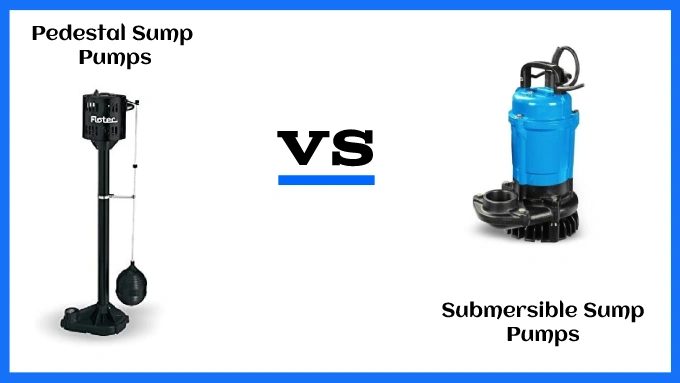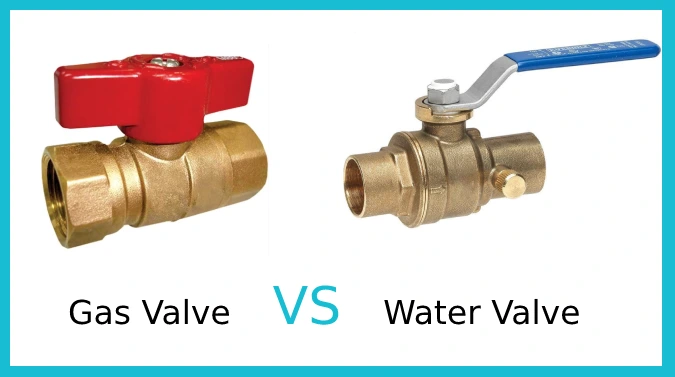Last Updated on April 30, 2023
Are you looking to install a sump pump in your basement or crawl space? If so, you may wonder if you should go with a pedestal or submersible sump pump. Both have their advantages and uses, but which one is most suitable for your home?
The primary distinction between these two types lies in their design and installation. Pedestal sump pumps feature an open-frame construction with the impeller mounted on a slender shaft above the sump pit, while submersible sump pumps house the impeller and motor inside the sump pit itself.
Beyond their structural differences, other factors may influence your decision, such as noise level, energy efficiency, pumping capacity, upkeep expenses, durability, and overall cost.
By carefully examining these variables, you can determine which sump pump system is optimal for protecting your home and ensuring its long-term integrity. Let’s dive in.
The Differences between Pedestal Vs Submersible Sump Pump

While both types of sumps provide reliable water-draining solutions, several key differences between the two should be considered when making a purchasing decision. Here is a closer look at the distinction between a pedestal sump pump and a submersible.
01: Installation
The primary difference between pedestal and submersible sump pumps is in the installation method.
A pedestal sump pump is typically installed outside of the sump pit. It is mounted to a floor or wall near the pit, with a long pipe leading into it. This type of installation requires more space, as the motor is usually located several feet above the water line.
On the other hand, a submersible sump pump is installed directly inside the pit to completely submerge underwater. This type of installation requires less space since all components are contained within one unit and no pipework is necessary.
02: Design
In terms of design, pedestal sump pumps have a longer, cylindrical shaft to support the impeller, while submersible pumps have a shorter, compact design where all components are housed in one unit.
Pedestal pumps also usually feature vents at their base to prevent overheating and allow for proper ventilation. In contrast, submersible pumps are designed to be waterproof and airtight, so they can work submerged without any additional ventilation requirements.
03: Noise Level
The noise level produced by pedestal sump pumps tends to be higher than that of submersible varieties due to their location outside of the pit. The motor must run at a higher speed to lift the water up through pipes leading into the pit, creating more noise as a result.
Submersible sump pumps are much quieter because they are situated inside the water tank and therefore require less power consumption and noise production for operation.
04: Power Consumption
Energy consumption often varies between different types of sump pumps, depending on factors such as size and design.
Generally speaking, submersible models tend to be more energy efficient than pedestal models due to their lower operating speed and decreased electricity use for pumping water up from outside sources.
Also, submersible models don’t require additional piping or air vents which further reduces energy consumption compared to pedestal designs.
05: Pumping Capacity

When comparing the pumping capacity of pedestal sump pumps and submersible sump pumps, it is clear that submersible models offer greater power. This makes them ideal for larger pits or areas with high water inflow.
Submersible sump pumps are designed to draw water from deeper depths and move it at higher volumes than pedestal models. Also, since they are submerged in water, they also benefit from a cooling effect which prevents the motor from overheating.
06: Maintenance
Pedestal sump pumps have an advantage when it comes to maintenance due to their easy accessibility. Since these models are not submerged in water, they can be more easily inspected, cleaned, and serviced by simply removing the pump from the pit.
Submersible sump pumps require more effort for maintenance because they must first be removed from the pit before any inspection or service can take place.
Due to their enclosed design and being submerged in water, debris can accumulate on the outside making regular cleaning more difficult as well.
07: Durability
In terms of durability, pedestal sump pumps are designed to last longer due to the fact that they are not constantly submerged in water. This greatly reduces the risk of wear and tear, rust corrosion, and other mechanical problems.
Submersible sump pumps can also be quite durable, but since these models are always exposed to water, there is a higher chance for mechanical issues to occur over time.
In addition, submersible models typically have shorter lifespans ranging between 5 to 10 years, while pedestal models last much longer with 25 to 30 years of expected life cycles.
To maximize the durability of a submersible sump pump, it is important to regularly inspect and clean it from any debris that may have accumulated on its exterior.
08: Cost
Generally speaking, pedestal sump pumps tend to be less expensive due to their simpler design, while submersible sump pumps may cost more due to their added complexity.
While cost can vary depending on brand and model, this general rule usually applies across the board when shopping for these types of pumps.
Where Can You Find Cost Effective Pedestal Sump Pump?

Finding a cost-effective pedestal sump pump can be difficult, but it can be easy with the right research and resources. One of the simplest ways to find a pedestal sump pump at a reasonable price is to shop online.
By shopping online, you can compare specs, reviews, and prices, allowing you to find the most suitable product at the most reasonable price. Also, you don’t need to waste time visiting physical stores or local dealerships when shopping online.
For those who are looking for high-quality yet affordable pedestal sump pumps, we suggest checking out our reviews of some of the best pedestal sump pumps available. We review several models to ensure that we only recommend trustworthy options that will provide reliable performance for years.
What is the Advantage of a Pedestal Sump Pump?
A pedestal sump pump offers a few advantages when compared to submersible pumps. One of the most important benefits is their longer lifespan. Pedestal sump pumps are known to last 2 to 5 times longer than submersible models, making them an economical choice for residential and commercial applications.
Also, pedestal sump pumps typically require less maintenance than submersible models, saving you time and money in the long run. Furthermore, because these pumps are designed with an above-ground motor, they are much safer to install and operate than traditional submersible options.
Can a Pedestal Sump Pump Get Wet?

The motor on a pedestal pump is placed above ground while the pump sits at the bottom of the sump. This design helps keep the motor safe from any water entering the system during operation or if there is flooding in your area.
It’s important to note that although this keeps the motor dry, it does not protect it against electrical surges or shorts caused by rain or other weather-related events.
To further protect your equipment from water damage, make sure to use an outdoor-rated power cord with quality insulation and properly connect your device to a GFCI outlet or breaker box.
Can I Replace a Pedestal Sump Pump with a Submersible?

You can replace it, but before replacing your current setup, it’s a good idea to research all available options and compare features in terms of price and performance capabilities to find one that perfectly suits your needs and budget.
When embarking on the task of replacing a pedestal pump with a submersible one, it is crucial to prioritize safety and adhere to proper procedures to ensure a seamless transition.
Begin by disconnecting all electrical connections associated with the old setup, eliminating any potential hazards during removal.
With diligent attention to the manufacturer’s instructions, proceed to install any new components included in your replacement pump kits, such as valves or check valves. This attention to detail will prevent complications from arising later on.
Following a thorough installation, test the functionality of your new submersible unit before powering it up. This critical step allows you to confidently verify its performance, rectify any leaks or other problems that may present themselves, and guarantee a successful integration back into service.
Trusting this professional approach will result in a smooth, efficient, and safe upgrade of your pump system.
Which Is Better: Pedestal Pump Vs Submersible Sump Pump?
Selecting the ideal sump pump for your specific requirements can be challenging, particularly when faced with the choice between a pedestal and a submersible option.
Both types come with unique advantages and drawbacks, which should be considered before making the final decision. For instance, a pedestal sump pump often outlasts its submersible counterpart, making it a reliable choice for those seeking longevity.
But, if your primary concern is a higher pumping capacity, a submersible sump pump may better fulfill your needs. Ultimately, comprehending your requirements and carefully evaluating the various factors associated with each type of pump is crucial for identifying the most suitable choice for your unique situation.




I disagree with the statement “A pedestal sump pump is typically installed outside of the sump pit. It is mounted to a floor or wall near the pit……”
Ref: 01 INSTALLATION, paragraph 2.
Mounted to a floor or wall outside the pit??
I’ll assume it is a typo error. Pedestal pumps SIT on their impeller casing at the bottom – INSIDE the sump pit. Rgid outflow piping keep the pedestal in installed position, requiring no additional anchoring.
Thanks for pointing that out! You’re correct that pedestal sump pumps are designed to sit on the impeller casing at the bottom of the sump pit, not mounted outside of it. The rigid outflow piping helps keep the pump in place without needing additional anchoring. It looks like there might have been a mix-up in the description. Pedestal pumps are indeed installed inside the pit, and your clarification is much appreciated! Hopefully, the article will updated to reflect this accurately.